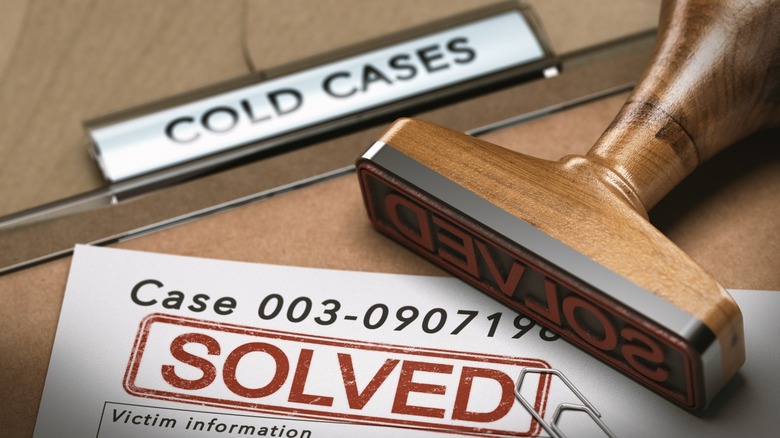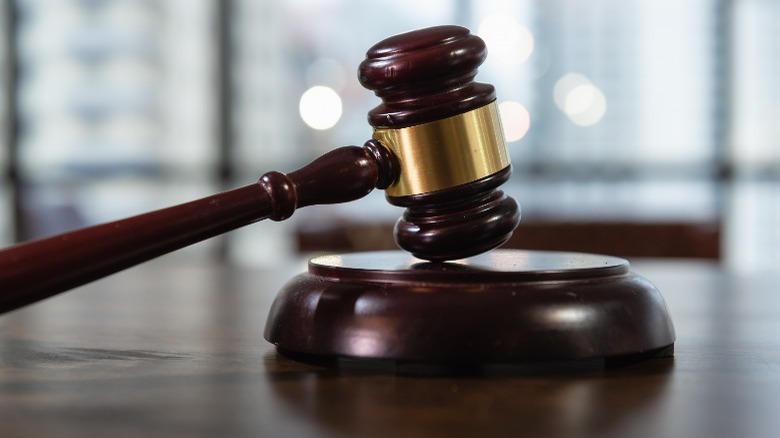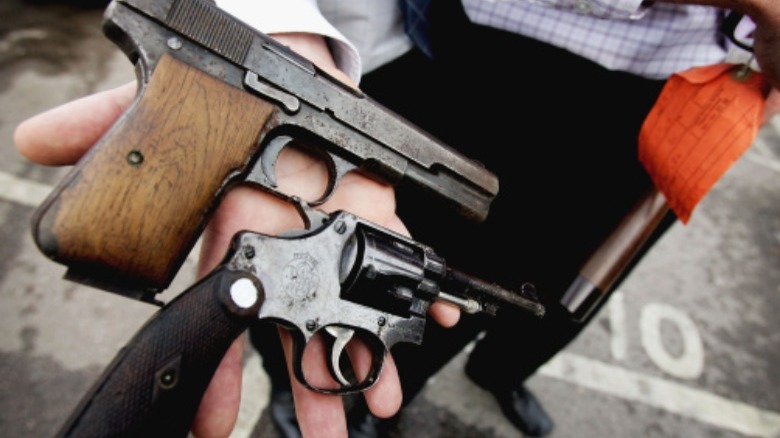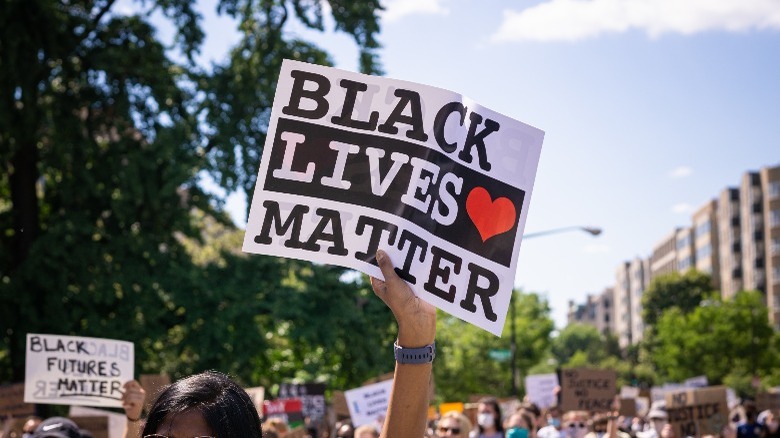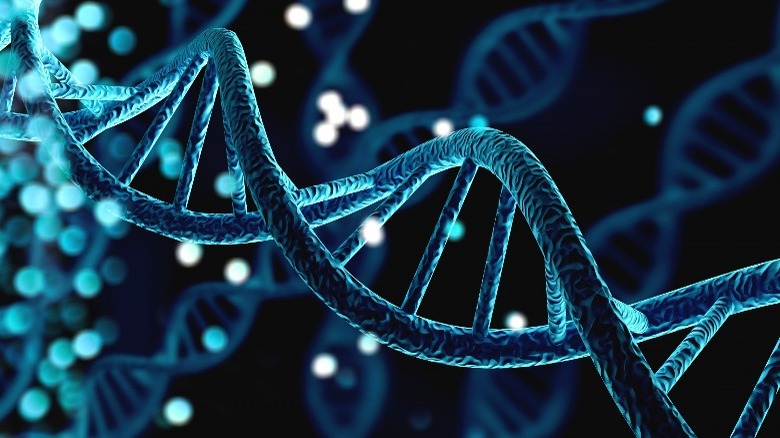Why Do Cold Cases Often Never Get Solved?
While gun violence is on the rise in the United States, solved murder cases are on the decline. Per FBI data cited in The Atlantic, 90% of murders in the U.S. were "cleared" by police in the 1960s. "Cleared" means a suspect was arrested or identified as dead or already imprisoned. It doesn't necessarily mean a conviction followed (via NPR). In 2020, that national rate fell to around 50; the lowest it has ever been, according to The Atlantic.
One reason is that crime waves in the 1970s and 1980s caused many American police departments to begin focusing on prevention rather than solving cases. In some cities with especially low clearance rates, the focus is now shifting back in the other direction (via NPR). However, this is far from the only reason that cases — both old and new — aren't being solved at a higher rate. Factors, including legal procedures, police funding, racial issues, and even how the crime is committed, all play a role. This is especially true when examining cold cases.
Standards for charging a suspect
Vernon Geberth, a former police officer and an expert on solving murders, believes changing standards for charging someone after an arrest is partially to blame for higher rates of unsolved crimes, including cold cases. Expectations among prosecutors have gotten higher — too high, Geberth argues. Prosecutors want to be certain of getting a plea bargain or a conviction before a suspect is ever charged in the first place. They want to leave little room for doubt that the suspect did, in fact, commit the crime (via NPR).
These high expectations may come from training. In the National District Attorneys Association's guide for prosecutors, they list many different aspects of a case the prosecutor should consider before charging someone. This does include "the probability of conviction" and some other obvious things like the severity of the crime and the recommendation of the police involved in the investigation. It also states many things to take into consideration about the suspect as an individual: Do they contribute positively to their community? Are they elderly or disabled? Are they willing to cooperate with law enforcement? Are they the only ones responsible for the crime? It's a weighty decision.
The murder weapon
When it comes to cold case homicides, one of the barriers to solving them is simple and fundamental: The murder weapon. Murders committed with guns and other firearms are more difficult to solve than those committed with other types of weapons. The New York Times notes that cities with fewer shooting deaths have a higher rate of solved murders. New York City cleared 86% of murders in 2019, but only 54% of murders in the city that year were committed with firearms. Comparatively, Dayton, Ohio, only cleared 21% of murders, but 94% of murders in Dayton that year were committed with a firearm.
What makes shooting deaths harder to solve? One reason is that the perpetrators are unlikely to have left as much DNA, per National Geographic. Another reason, cited by The New York Times, is that firearms are more likely to be used in cases where the victim and perpetrator don't know each other. This includes situations where the homicide occurs while another felony is being committed — a theft, arson, or drug deal, for example (via Legal Match). The lack of an obvious link between the victim and perpetrator can hinder the investigation.
Resources dedicated to an investigation
According to The New York Times, a 2019 study of homicides in Boston showed the most important factor in solving cases was adequate resources. That means more manpower, more time, and more money dedicated to the investigation. The Times reported that more people working on the case meant more witnesses being identified and convinced to speak up.
Philadelphia police officers interviewed by CBS agreed. Regarding clearances of murder cases, they attributed their low rates to the "volume" of cases. In 2021, 562 murders were committed in Philadelphia, or about 11 per week — too many for the amount of personnel they have. As Geberth pointed out, modern homicide investigations can also involve so many steps and so much bureaucracy to assure conviction, the need for greater manpower is even higher than in the past (via NPR). Philadelphia Police Commissioner Danielle Outlaw told CBS, "[I]t's going to take more than the police to clear these cases."
These officers noted how time-consuming and expensive murder investigations can be, according to NPR. For example, according to NBC 12, in 2018, Richmond, Va. had one of the highest clearance rates among U.S. cities. NPR attributed Richmond's high clearance rate to reorganization so that its police department's detectives got fewer cases and the department was better funded. However, many cities just don't have the money to take steps like these.
The police and communities of color
The CBS report pointed out the deterioration of the relationship between police and communities of color in the past decade. It also noted that when a homicide victim is Black or Hispanic, the case is far more likely to go cold than when the victim is white. A study from The Washington Post backed this up. Citing 2018 statistics, they said almost three-quarters of victims of unsolved homicides in the past decade in the U.S. were Black. Overall, police arrest someone in 63% of homicide investigations where the victim is white, but only 47% where the victim is Black. The disparity was highest in Boston, but also stark in Chicago, Baltimore, Detroit, and Philadelphia.
When asked by CBS if communities of color should trust the police more, Philadelphia Police Commissioner Danielle Outlaw said no. "We're talking about historically issues, systemic inequities that contribute to the mistrust," she explained. "Then also things that the police have done, and we've gotten in our own way. It has to be a two-way street, as it is with any relationship."
Civil rights leader Rev. William Barber told The Washington Post, "Black life is seen as not as important." Boston activist Rufus Faulk agreed and also said that demonization of Black victims as being criminals themselves leads to less public interest in the cases, thus less help for the investigations.
Reluctant witnesses
One of the most significant barriers to solving cold cases — noted by many different people and publications — is the lack of witnesses to the crimes. It's a problem directly linked to the previous one. When people of color, especially Black people, don't trust the police, they're much less likely to come forward to give information about a crime (via The Washington Post). This isn't the only reason, however. People may also refuse to provide information because of fear of retaliation, according to National Geographic. Young people interviewed in Philadelphia said calling the police to report a crime seemed "futile" to them — even if the police don't escalate the situation, an arrest is unlikely to significantly change long-term problems in the community, they said (via The Root). They also said that supposed crime-prevention tactics like "stop-and-frisk" have further damaged police and community relationships, as has mass incarceration.
National Geographic states that finding new witnesses remains the most likely way to solve a cold case. The publication cited a 2014 study published in the Journal of Forensic Sciences. The study looked at 189 old case investigations from Washington, D.C. Around 48% of the reopened cases were ultimately "cleared," and in 63% of the "cleared" cases, new witnesses were key to solving them. DNA matches, in contrast, only contributed to 3% of the "cleared" cases. It seems law enforcement will need to improve their relationships with their communities before cold case rates will improve.
